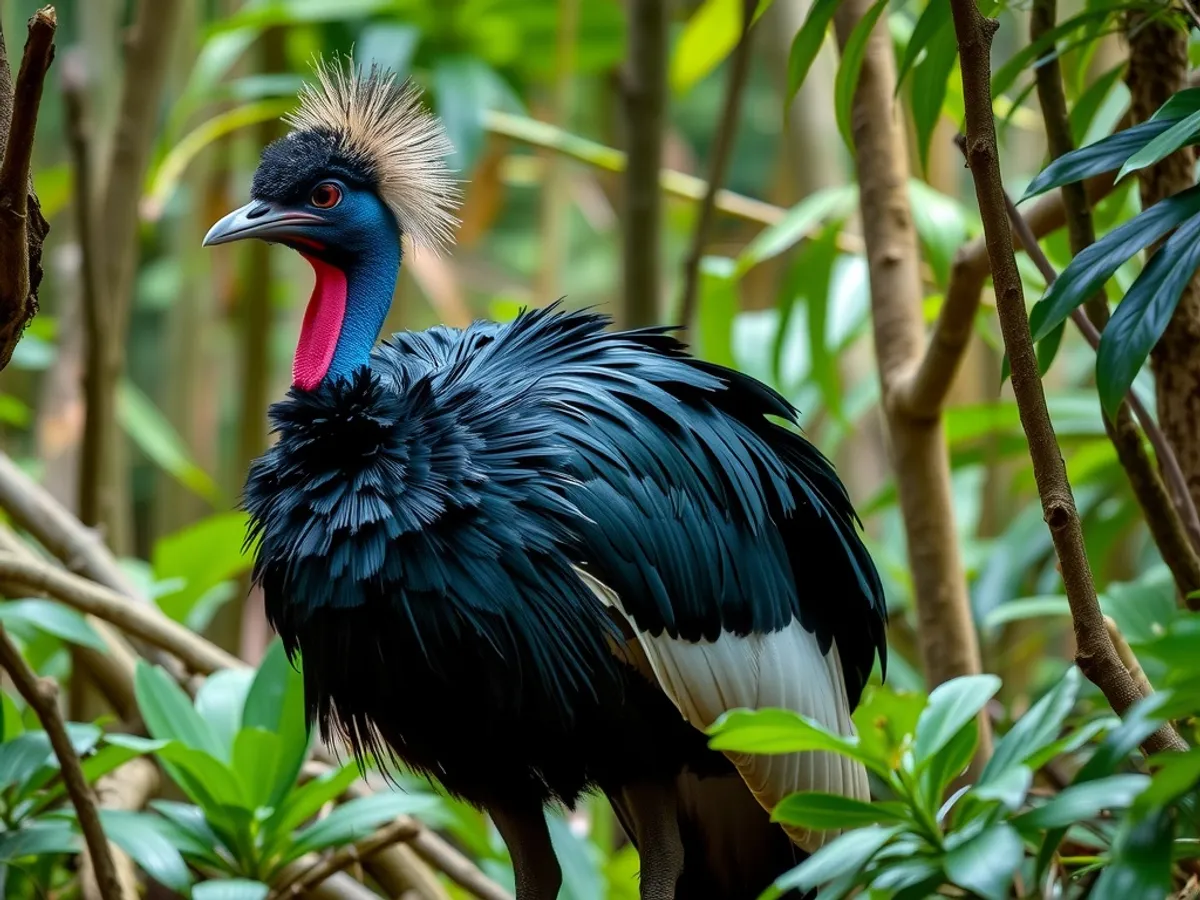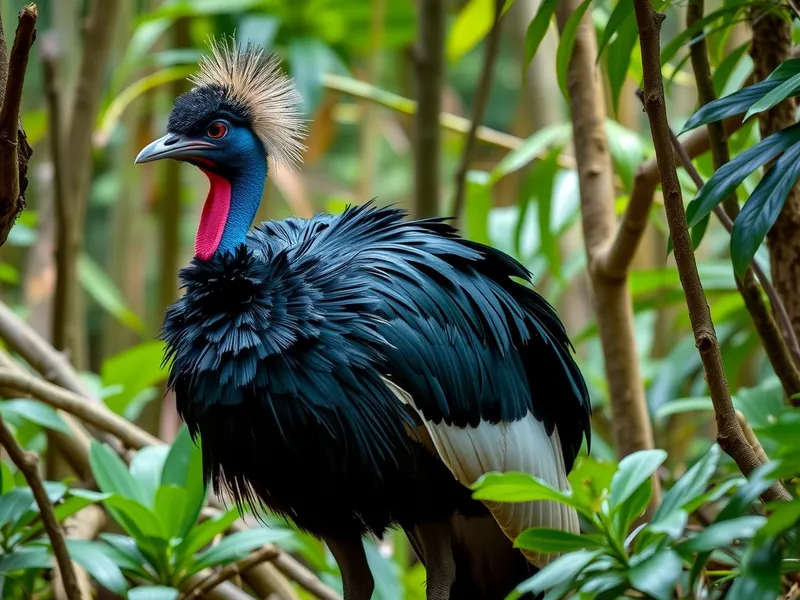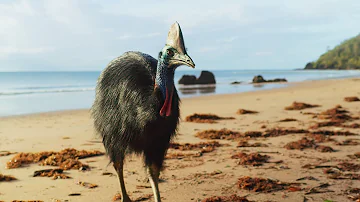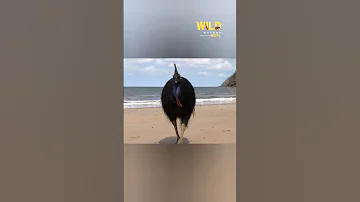
Southern Cassowary
Casuarius casuarius

Meet the Southern Cassowary
The Southern Cassowary is a large, flightless bird native to the tropical rainforests of New Guinea, northeastern Australia, and nearby islands. Recognized by its striking black plumage, vivid blue and red neck skin, and a prominent helmet-like casque on its head, it is the heaviest bird in Australia and the second heaviest in the world. Southern Cassowaries are shy yet potentially dangerous, known for their powerful legs and sharp claws, which they use for defense. They play a vital role in their ecosystem by dispersing seeds of many rainforest plants, making them a keystone species.
Classification
Bird
Habitat
Tropical rainforest
Diet
Omnivore
Lifespan
40-50 years
Conservation
Vulnerable
Weight
35-58 kg
📖Fascinating Facts
Unusual Parenting
Male Southern Cassowaries are solely responsible for incubating the eggs and raising the chicks after they hatch.
Fruit Lovers
Their diet consists mainly of fallen fruit, but they also eat fungi, insects, and small animals when available.
Powerful Kick
Cassowaries have a dagger-like claw on each foot, up to 12 cm long, capable of inflicting serious injury when threatened.
📋Detailed Description
The Southern Cassowary (Casuarius casuarius) is a large, flightless ratite, reaching up to 1.8 meters (5.9 ft) in height and weighing between 35–70 kg (77–154 lbs), making it the heaviest bird in Australia and second only to the ostrich globally. Its plumage consists of coarse, black, hair-like feathers that provide protection from the dense rainforest undergrowth. The bare skin of the neck and head displays vivid blue and purple hues, with red wattles hanging from the throat, and a prominent keratinous casque atop the head, which may function in sound resonance, protection, or as a display structure. The bird's powerful legs are equipped with three toes, each bearing a sharp claw, with the inner claw reaching up to 12 cm (4.7 in) and capable of inflicting serious injury. Southern Cassowaries are solitary and highly territorial, using deep booming calls to communicate through dense vegetation. Their diet is primarily frugivorous, consuming over 238 species of rainforest fruits, but also includes fungi, invertebrates, and small vertebrates. They are crucial seed dispersers, capable of swallowing large fruits whole and transporting seeds over long distances. Cassowaries are generally shy but can become aggressive, especially when threatened or during the breeding season. Their cryptic coloration, secretive habits, and ability to run up to 50 km/h (31 mph) and jump up to 1.5 meters (5 ft) aid in evasion from predators and humans.
💡 Did you know?
Despite their size and fearsome reputation, Southern Cassowaries are crucial for rainforest regeneration due to their unique ability to spread large seeds over long distances.
🔬Research & Sources
Wikipedia Summary
The southern cassowary, also known as double-wattled cassowary, Australian cassowary, or two-wattled cassowary, is a large flightless black bird, found in Indonesia, Papua New Guinea, and northeastern Australia. It is one of the three living species of cassowary, alongside the dwarf cassowary and the northern cassowary. It is a ratite and therefore related to the emu, ostrich, rhea and kiwi.
Last Modified: 5/25/2025
🎭Behavior & Social Structure
Southern Cassowaries are predominantly crepuscular, being most active during dawn and dusk. They are solitary, occupying overlapping home ranges of up to 7 km², which they defend with vocalizations, threat displays, and, if necessary, physical aggression. Their feeding behavior is opportunistic; they forage for fallen fruits, using their acute sense of smell to locate food, and will also consume fungi, insects, snails, small reptiles, and carrion. Cassowaries are known to follow fruiting cycles and can travel long distances in search of food. They use low-frequency booming calls (as low as 23 Hz, among the lowest of any bird) to communicate, especially during mating season or to warn intruders. Social interactions are limited outside of breeding, with encounters between adults often resulting in displays of dominance or avoidance. They maintain well-defined latrine sites for defecation, which play a role in seed dispersal and territory marking.
👶Reproduction & Life Cycle
Breeding occurs during the dry season, typically from June to October in Australia. Males construct a ground nest from leaf litter and vegetation in dense forest cover. After a brief courtship, females lay 3–5 large, glossy green eggs, each measuring about 14 x 9 cm (5.5 x 3.5 in) and weighing up to 650 g (1.4 lbs). Uniquely among birds, the male assumes all parental duties: he incubates the eggs for 50–52 days, rarely leaving the nest, and then cares for the striped brown-and-cream chicks for up to nine months. During this period, the male teaches the chicks foraging skills and protects them from predators. Females are polyandrous, mating with multiple males and leaving each to rear his own clutch. Sexual maturity is reached at 2.5–3 years.
🛡️Adaptations & Survival
Southern Cassowaries exhibit several adaptations for rainforest life: their dense, bristle-like plumage protects against thorny vegetation and rain. The casque, composed of spongy bone covered in keratin, may help them push through undergrowth, serve as a secondary sexual characteristic, or assist in amplifying low-frequency vocalizations. Their powerful legs enable rapid running, leaping, and swimming, while the dagger-like inner claw serves as a formidable defense against predators. Their digestive system is adapted to process large, tough fruits, and their tolerance for toxic or astringent plant compounds allows them to consume a wide variety of rainforest fruits, many of which are inedible to other animals. Their solitary and cryptic behavior reduces detection by predators and humans.
📚Research Sources
🎨Cultural Significance
The Southern Cassowary holds significant cultural importance for Indigenous peoples of New Guinea and northern Australia, featuring in creation myths, traditional dances, and as a totemic animal. Its feathers, bones, and eggs have been used in ceremonial attire and tools. In some regions, cassowaries are associated with fertility, forest spirits, or as guardians of the rainforest. The bird's formidable reputation has led to its depiction in local folklore as both a symbol of danger and a protector of the forest. Conservation programs increasingly incorporate Indigenous knowledge and stewardship.
🔬Recent Research & Discoveries
Recent research has focused on the cassowary's role as a keystone seed disperser, with studies demonstrating its ability to disperse large-seeded plants over distances exceeding 5 km, thus maintaining rainforest diversity and structure. Genetic studies are clarifying population structure and connectivity, particularly in fragmented Australian habitats. Ongoing research investigates the function of the casque, with hypotheses ranging from acoustic resonance to thermoregulation. Conservation science is examining the effectiveness of wildlife corridors, road mitigation measures, and community engagement in reducing human-cassowary conflict. Advances in remote camera trapping and GPS telemetry are providing new insights into cassowary movement ecology and habitat use.
🎥Wildlife Videos

Giant Cassowaries are Modern-day Dinosaurs | Seven Worlds, One Planet | BBC Earth
Conservation short. Seven Worlds, One Planet Episode 4 'Australia' Millions of years ago incredible forces ripped apart the ...
BBC Earth

Southern cassowary (mini documentary)
Come with me to meet the Southern cassowary... #Southerncassowary #cassowary.
Awesome Animals

Killer Cassowaries: The Worlds Most Dangerous Bird To Walk The Planet
In the ancient rainforests of Northeast Australia a living dinosaur is making a last Stand this magnificently weird creature is known ...
Apex Predators

Southern Cassowary Documentary
ANM102 Assignment.
oliviakimber

Cassowaries - Animal documentary #wildanimals #nature #documentary #wildnaturehdtv
WildNature HDTv

Cassowaries: Nature's Living Dinosaurs | Wild to Know
Cassowaries are often referred to as “dinosaur birds”. In fact, these astonishing avians are descended from theropods, the only ...
Terra Mater
🌍Habitat Information
The Southern Cassowary typically inhabits Tropical rainforest environments. Southern Cassowarys have adapted to their environments with specialized features and behaviors.
Primary Habitat:
Tropical rainforest
More detailed habitat information will be available soon.
🛡️Conservation Status
The Southern Cassowary is currently classified as Vulnerable. Conservation efforts are crucial for preserving this species for future generations.
Common Threats:
- 🏠Habitat loss and fragmentation
- 🌡️Climate change impacts
- 🎯Hunting and poaching
- 🏭Human-wildlife conflict
⚠️Threats & Conservation Challenges
Major threats to the Southern Cassowary include habitat loss and fragmentation due to deforestation, urban development, and agriculture, particularly in northeastern Australia where populations are most isolated. Vehicle strikes are a significant cause of mortality, as cassowaries often cross roads in search of food or mates. Predation on eggs and chicks by feral pigs, dogs, and invasive species further reduces recruitment. Human feeding can lead to habituation, aggression, and increased risk of vehicle collision. Climate change poses additional risks by altering fruiting patterns and increasing the frequency of cyclones, which can devastate rainforest habitat. The global population is declining, with estimates of fewer than 4,600 mature individuals in Australia, leading to its listing as Endangered under the EPBC Act, despite a broader IUCN status of Least Concern due to larger populations in New Guinea.
🔬Scientific Classification
Scientific Name
Casuarius casuarius
Classification Hierarchy
🔍 About Taxonomic Classification
Taxonomic classification is a hierarchical system used by scientists to classify and organize living organisms based on shared characteristics and evolutionary relationships.
The system moves from broad categories (Kingdom) to increasingly specific ones, with each animal's scientific name typically consisting of its Genus and species.
📝Community Notes
Share your observations and insights about the Southern Cassowary with our community of wildlife enthusiasts.
Join Our Community
Sign in to share your observations and connect with fellow wildlife enthusiasts.
Sign In to ContributeNo community notes yet
Be the first to share your observations about the Southern Cassowary!
Explore Southern Cassowary
Select a tab above to learn more about this amazing animal.
📸Photo Gallery
No photos available for this animal yet.
🌟Discover More Wildlife
Continue your journey of discovery with more fascinating animals from our database
